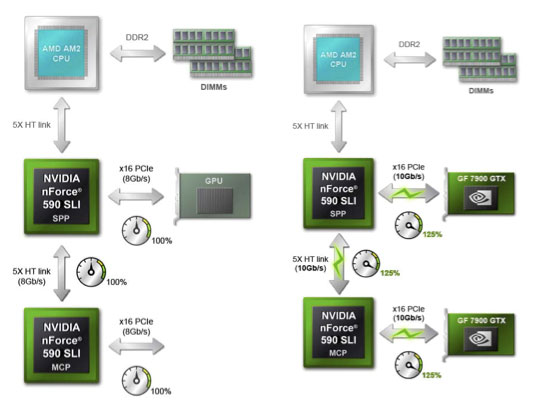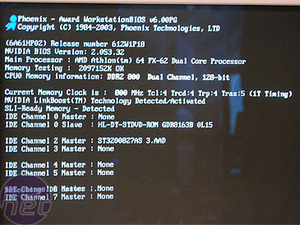LinkBoost
NVIDIA is staking its claim as a true 'platform provider' with the nForce 500-series, and it is using its leverage in the graphics market to get the best possible experience for enthusiasts and gamers using its motherboards. If you combine an NVIDIA GeForce 7900 GTX video card with an nForce 590 SLI-based motherboard, you will get some benefits - the first being LinkBoost technology.LinkBoost increases the clock speeds of certain mainboard features when it detects a compatible video card or pair of video cards - i.e. cards that NVIDIA knows will be able to take the extra strain. This requires no user intervention and makes for hassle-free overclocking. NVIDIA calls this 'Faster Clocks Out-of-the-Box'. Rather than sticking to standard specifications for the sake of interoperability, NVIDIA is playing with those specifications in situations where it knows what the hardware is.

Chipset clocks without LinkBoost (left) and with (right).
The clocks increased are the PCI-Express bus to the video card and the HyperTransport link between the SPP and MCP on the mainboard. These clocks are increased by 25%, giving a HyperTransport bus of 10Gb/sec (as opposed to 8Gb/sec) and a PCI-Express graphics bus of 10Gb/sec (also up from 8Gb/sec).
Currently, the only video card that supports LinkBoost on nForce 590 SLI is the GeForce 7900 GTX. More will be added as new cards are released. LinkBoost provides a 'guaranteed overclock', but those who want to delve into the BIOS will find that there is headroom there to push those buses even further if they wish.
SLI Memory
Related to LinkBoost (in that it provides guaranteed overclocking), SLI Memory is a new standard for certified memory for the nForce 500-series platform. SLI Memory includes the Extended Performance Profile (EPP) that we previously reported on.EPP has been developed by Corsair and NVIDIA, but will be adopted by other memory manufacturers including OCZ and Kingston. Although it is not a fully ratified addition to the JEDEC specification, it will be adopted independently by many parties. Memory containing EPP information will run at optimised speeds on nForce 500-series motherboards with only a little fiddling in the BIOS. All newly-released Corsair XMS DDR2 memory modules will have EPP built in.


NVIDIA suggests that this will provide a 'guaranteed first success' at overclocking for the novice. For experts, the data provided in the EPP and the major system detailing exposed by the BIOS in top-end nForce 500-series motherboards will allow the maximum amount of information needed to overclock to the highest speeds.

MSI MPG Velox 100R Chassis Review
October 14 2021 | 15:04






Want to comment? Please log in.